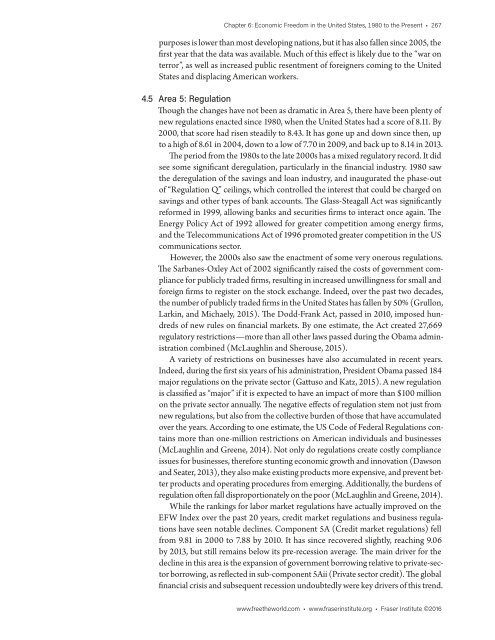Economic Freedom of the World
economic-freedom-of-the-world-2016
economic-freedom-of-the-world-2016
Create successful ePaper yourself
Turn your PDF publications into a flip-book with our unique Google optimized e-Paper software.
Chapter 6: <strong>Economic</strong> <strong>Freedom</strong> in <strong>the</strong> United States, 1980 to <strong>the</strong> Present • 267<br />
purposes is lower than most developing nations, but it has also fallen since 2005, <strong>the</strong><br />
first year that <strong>the</strong> data was available. Much <strong>of</strong> this effect is likely due to <strong>the</strong> “war on<br />
terror”, as well as increased public resentment <strong>of</strong> foreigners coming to <strong>the</strong> United<br />
States and displacing American workers.<br />
4.5 Area 5: Regulation<br />
Though <strong>the</strong> changes have not been as dramatic in Area 5, <strong>the</strong>re have been plenty <strong>of</strong><br />
new regulations enacted since 1980, when <strong>the</strong> United States had a score <strong>of</strong> 8.11. By<br />
2000, that score had risen steadily to 8.43. It has gone up and down since <strong>the</strong>n, up<br />
to a high <strong>of</strong> 8.61 in 2004, down to a low <strong>of</strong> 7.70 in 2009, and back up to 8.14 in 2013.<br />
The period from <strong>the</strong> 1980s to <strong>the</strong> late 2000s has a mixed regulatory record. It did<br />
see some significant deregulation, particularly in <strong>the</strong> financial industry. 1980 saw<br />
<strong>the</strong> deregulation <strong>of</strong> <strong>the</strong> savings and loan industry, and inaugurated <strong>the</strong> phase-out<br />
<strong>of</strong> “Regulation Q” ceilings, which controlled <strong>the</strong> interest that could be charged on<br />
savings and o<strong>the</strong>r types <strong>of</strong> bank accounts. The Glass-Steagall Act was significantly<br />
reformed in 1999, allowing banks and securities firms to interact once again. The<br />
Energy Policy Act <strong>of</strong> 1992 allowed for greater competition among energy firms,<br />
and <strong>the</strong> Telecommunications Act <strong>of</strong> 1996 promoted greater competition in <strong>the</strong> US<br />
communications sector.<br />
However, <strong>the</strong> 2000s also saw <strong>the</strong> enactment <strong>of</strong> some very onerous regulations.<br />
The Sarbanes-Oxley Act <strong>of</strong> 2002 significantly raised <strong>the</strong> costs <strong>of</strong> government compliance<br />
for publicly traded firms, resulting in increased unwillingness for small and<br />
foreign firms to register on <strong>the</strong> stock exchange. Indeed, over <strong>the</strong> past two decades,<br />
<strong>the</strong> number <strong>of</strong> publicly traded firms in <strong>the</strong> United States has fallen by 50% (Grullon,<br />
Larkin, and Michaely, 2015). The Dodd-Frank Act, passed in 2010, imposed hundreds<br />
<strong>of</strong> new rules on financial markets. By one estimate, <strong>the</strong> Act created 27,669<br />
regulatory restrictions—more than all o<strong>the</strong>r laws passed during <strong>the</strong> Obama administration<br />
combined (McLaughlin and Sherouse, 2015).<br />
A variety <strong>of</strong> restrictions on businesses have also accumulated in recent years.<br />
Indeed, during <strong>the</strong> first six years <strong>of</strong> his administration, President Obama passed 184<br />
major regulations on <strong>the</strong> private sector (Gattuso and Katz, 2015). A new regulation<br />
is classified as “major” if it is expected to have an impact <strong>of</strong> more than $100 million<br />
on <strong>the</strong> private sector annually. The negative effects <strong>of</strong> regulation stem not just from<br />
new regulations, but also from <strong>the</strong> collective burden <strong>of</strong> those that have accumulated<br />
over <strong>the</strong> years. According to one estimate, <strong>the</strong> US Code <strong>of</strong> Federal Regulations contains<br />
more than one-million restrictions on American individuals and businesses<br />
(McLaughlin and Greene, 2014). Not only do regulations create costly compliance<br />
issues for businesses, <strong>the</strong>refore stunting economic growth and innovation (Dawson<br />
and Seater, 2013), <strong>the</strong>y also make existing products more expensive, and prevent better<br />
products and operating procedures from emerging. Additionally, <strong>the</strong> burdens <strong>of</strong><br />
regulation <strong>of</strong>ten fall disproportionately on <strong>the</strong> poor (McLaughlin and Greene, 2014).<br />
While <strong>the</strong> rankings for labor market regulations have actually improved on <strong>the</strong><br />
EFW Index over <strong>the</strong> past 20 years, credit market regulations and business regulations<br />
have seen notable declines. Component 5A (Credit market regulations) fell<br />
from 9.81 in 2000 to 7.88 by 2010. It has since recovered slightly, reaching 9.06<br />
by 2013, but still remains below its pre-recession average. The main driver for <strong>the</strong><br />
decline in this area is <strong>the</strong> expansion <strong>of</strong> government borrowing relative to private-sector<br />
borrowing, as reflected in sub-component 5Aii (Private sector credit). The global<br />
financial crisis and subsequent recession undoubtedly were key drivers <strong>of</strong> this trend.<br />
www.free<strong>the</strong>world.com • www.fraserinstitute.org • Fraser Institute ©2016


